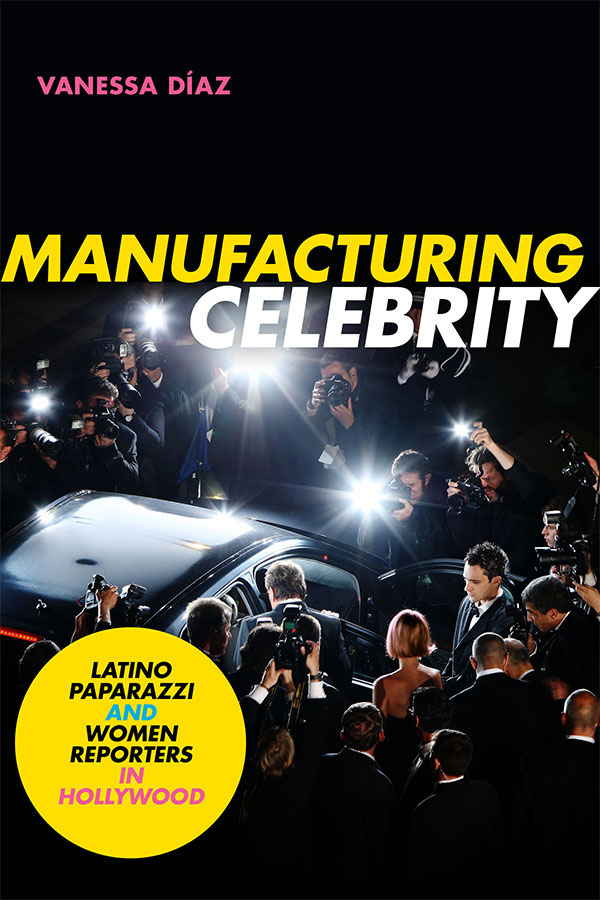 Celebrity magazines such as People Magazine, The National Enquirer, and Us Weekly have helped build and maintain the Hollywood industrial complex. Despite their importance to understanding celebrity culture, these publications are frequently perceived as being peripheral to entertainment industry. Scholars such as Anne Helen Petersen,2 who wrote about the industrial history of celebrity gossip, and Erin A. Meyer,3 who undertook extensive archival research on reality TV celebrities in Us Weekly, have focused primarily on the manufacture of celebrity. Thus far, no scholars have produced ethnographic studies on the processes involved in creating content for these celebrity magazines.4 In Manufacturing Celebrities: Latino Paparazzi and Women Reporters in Hollywood, anthropologist Vanessa Díaz fills a gap by supplementing existing media studies research, focused largely on the texts themselves or their consumption practices, and offers a vivid and nuanced production studies–oriented study of paparazzi and celebrity reporters.
Celebrity magazines such as People Magazine, The National Enquirer, and Us Weekly have helped build and maintain the Hollywood industrial complex. Despite their importance to understanding celebrity culture, these publications are frequently perceived as being peripheral to entertainment industry. Scholars such as Anne Helen Petersen,2 who wrote about the industrial history of celebrity gossip, and Erin A. Meyer,3 who undertook extensive archival research on reality TV celebrities in Us Weekly, have focused primarily on the manufacture of celebrity. Thus far, no scholars have produced ethnographic studies on the processes involved in creating content for these celebrity magazines.4 In Manufacturing Celebrities: Latino Paparazzi and Women Reporters in Hollywood, anthropologist Vanessa Díaz fills a gap by supplementing existing media studies research, focused largely on the texts themselves or their consumption practices, and offers a vivid and nuanced production studies–oriented study of paparazzi and celebrity reporters.
Díaz elucidates the racial, ethnic, gendered, and class politics involved in both the paparazzi and female celebrity reporters’ labor through extensive fieldwork on each group’s production practices and rich critical analysis of their working conditions. This image-filled book turns the camera on the people who are disenfranchised and rendered invisible in the glamorous Hollywood cultural sphere: the workers snapping photos and writing about celebrity-studded events. By shifting our focus, Díaz underscores the workers’ spaces as critical sites of social struggle, legitimization, and power in Hollywood. Díaz’s experience as a People Magazine celebrity reporter and intern dating back to 2004 helped her gain access to journalists, paparazzi, and magazine editors. Her ethnographic approach effectively situates her alongside the participating communities she encounters in the field. Building on anthropologists Yarimar Bonilla’s5 and Aimee Cox’s6 co-theorizing and unconditional relationality ethnographic approaches, Díaz’s work articulates the complex social dynamics and structural hierarchies that shape celebrity magazine content as coproduced by paparazzi and celebrity reporters.
The seven-chapter book, organized into three sections, is structured according to the range of social positions occupied by cultural workers. The first part, Pappin’ Ain’t Easy, focuses on the peripheral but crucial work of paparazzi in the celebrity magazine industry. The politics and working spaces of celebrity reporters figure centrally in the second part of the book, titled Reporting on the Stars. The third and final section, titled Crafting the Media and the Sociocultural Consequences, explores the editorial decisions that take place at People Magazine’s offices in New York and Los Angeles. In addition to decentering the media institution by focusing on the social spaces of paparazzi and celebrity reporters, this method of organization proves useful to understanding the cultural values, behaviors, and practices shaping different stages of production in celebrity magazines.
The first chapter, “Shooteando: The Real Paparazzi of Los Angeles,” counteracts the hegemonic discourses of criminalization and discrimination often used to depict paparazzi. It does so by placing Galo, a Latino paparazzi and Díaz’s main confidante throughout her study, as a central figure. Galo articulates the changing demographics in Los Angeles, the tedious labor practices, the communal relations among the paparazzi brotherhood, and the ways in which paparazzi bodies and their work are racialized, erased, and excluded from Hollywood.7
Rather than directly employing paparazzi, People Magazine and similar publications rely on agencies and brokers to mediate image licensing, sales, and agreements of exclusive content shot by independent paparazzi.8 Díaz’s second chapter, “Latinos Selling Celebrities: Economies and Ethics of Paparazzi Work,” examines the politics, economics, and ethics involved in the relationship between the magazines, photo agencies, image brokers, and independent paparazzi. Her interviews expose the private business arrangements between celebrities, magazines, and photo agencies. Díaz also addresses the uneven market value for different racialized celebrity bodies and demonstrates how a self-regulation process forms the paparazzi’s collective ethical standards.
In the concluding chapter of the first part of the book, Díaz highlights both the affective economies and economies of hate that contribute to the hegemonic, institutionalized cultural discourses against the racialized bodies of paparazzi. While paparazzi are crucial to sustaining Hollywood’s celebrity culture, their profession is despised and criminalized by stars and celebrity magazines, leading to spectacularized violent encounters against these precarious workers in media rituals of hate.
While part 1 of the book discusses the highly informal, marginalized labor of paparazzi, the two-chapter second part of the book, Reporting on the Stars, focuses more directly on the labor of media industries workers who manufacture celebrity status through stories and media coverage—celebrity reporters. The fourth chapter, “Red Carpet Rituals: Positionality and Power in a Surveilled Space,” examines the main actants in the red-carpet media ritual.9 Díaz’s fieldwork and interviews describe the power dynamics in the rushed, cacophonous, and highly surveilled workspace of red-carpet celebrity reporters. As she shows, reporters’ physical positions on the carpet equate to status and power. The order of media outlets, and their reporters, on the red carpet largely determines whether celebrities stop for an interview or not and the quality of their answers. Furthermore, Díaz points to the lack of attention generally given by reporters to nonwhite celebrities and illustrates the controlled nature of the brief celebrity interviews that take place on the red carpet.
Female celebrity reporters’ workspaces are the central focus of the fifth chapter. With this chapter, Díaz discusses the expected skills, attitudes, and strategies employed by celebrity reporters to produce media content. Díaz evocatively relates anecdotal accounts of the risky labor conditions celebrity reporters experience while working in informal, ad hoc spaces, ranging from classrooms and hospitals to celebrities’ doorsteps and nightclubs. This chapter seamlessly connects the institutional sexism women celebrity reporters face in the industry, visibility politics, and the media’s ambivalent relationship with sexual harassment within the circuits of commodification and celebrity monetization.
After describing in detail paparazzi’s and reporters’ labor and workspaces over the first five chapters, Díaz delves deeper, using her insider access to illuminate the celebrity magazine production process in the third part of the book, Crafting the Media & the Sociocultural Consequences. This section investigates the formal offices and workspaces enjoyed by editors and upper management, contrasting sharply against the make-do content creators’ spaces outlined in earlier chapters. By combining reporters’ and editors’ stories of the workplace discussions at People Magazine’s offices with a historical analysis of celebrity magazine coverage, Díaz addresses the discursive formations that have taken shape around women’s bodies and white heterosexual love. These two themes, she notes, have proven economically successful for celebrity magazines and significantly affect the images and stories paparazzi and reporters prioritize.
The sixth chapter, “Body Teams, Baby Bumps, Beauty Standards,” is deep dive into the workplace structure, the organization of labor, and the decision-making processes at People Magazine. Díaz focuses on the scrutiny of female celebrities’ bodies and the resulting coverage in celebrity magazines. As she discusses the policing of women’s bodies, Díaz characterizes the problematic definitions of attractiveness inherent in this type of magazine content and the resulting pressures these definitions place on readers. She underscores the fact that Hollywood celebrities enjoy social and economic privileges that enable them to maintain body standards unattainable by most women.
Finally, the seventh chapter, “‘Brad and Angelina: And Now … Brangelina!’: The Cultural Economy of (White) Heterosexual Love,” discusses the commodification of white heterosexual love as a business strategy that draws in a consistent readership. Such depictions facilitate emotional investment and familiarity with celebrities’ private lives. Epitomized by the “Brangelina” phenomenon, stars’ relationships become more important and more marketable than the individual celebrities themselves. However, as Díaz observes, the invocation of love in celebrity magazines and the practices of “name blending” historically have excluded nonwhite and nonheterosexual celebrity couples.
Throughout the book, Díaz offers a vivid and engaging account of the complex and nuanced lived experiences and social struggles of both paparazzi and celebrity reporters. Given the range of topics and diverse theoretical approaches, Manufacturing Celebrities: Latino Paparazzi and Women Reporters in Hollywood is a valuable resource for scholars interested in Latinx labor, feminist and gender studies, race studies, and cultural studies of production. Her work stands out as a study of the sector of the Hollywood industrial complex that builds and sustains the celebrity system according to raced, classed, and gendered practices. By decentering Hollywood and incorporating the production and dissemination of celebrity magazines into her discussion, Díaz invites us to consider the real people working in industries often dismissed as peripheral. In fact, she shows, there is nothing peripheral about this industry or its workers.
Notes
- Luis E. Rivera-Figueroa is a PhD student at the University of Texas at Austin in the Department of Radio-Television-Film. His research focuses on stardom, transnational media cultures, and Latin music cultures. ⮭
- Anne Helen Peterson, Scandals of Classic Hollywood: Sex, Deviance, and Drama from the Golden Age of American Cinema (NY: Penguin Group, 2014). ⮭
- Erin A. Meyer, Extraordinarily Ordinary: US Weekly and the Rise of Reality Television Celebrities (New Brunswick, NJ: Rutgers University Press, 2020). ⮭
- Vanessa Díaz, Manufacturing Celebrities: Latino Paparazzi and Women Reporters in Hollywood (Durham, NC: Duke University Press, 2020), 21. ⮭
- Yarimar Bonilla, Non-Sovereign Futures: French Caribbean Politics in the Wake of Disenchantment (Chicago, IL: University of Chicago Press, 2015). ⮭
- Aimee Cox, Shapeshifters: Black Girls and the Choreography of Citizenship (Durham, NC: Duke University Press, 2015). ⮭
- Like other immigrant workers, “paparazzi are needed to produce images for media corporations, but once their presence is deemed a nuisance, they must disperse and disappear, or make themselves otherwise seemingly invisible,” Díaz, Manufacturing Celebrities, 56. ⮭
- As Díaz argues, in this model, paparazzi “are the workers operating in the informal channels of an often highly formal media production, within a hugely profitable corporate system, doing the dirty work for the celebrity media industry,” Díaz, Manufacturing Celebrities, 94. ⮭
- Díaz points to these events’ significance, “from obtaining permission to enter the carpet to the barricading of the reporters; how the order of the media outlets is determined; the gender dynamics at play on the red carpet; the strategic arrival and presentation of celebrities; the various kinds of negotiations that take place in the red carpet; and the spectacle,” Díaz, Manufacturing Celebrities, 127. ⮭

